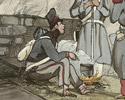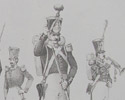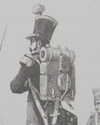19th Century´s militar history in the Basque Country
The liberal infantry
 With the exception of some officials who were removed from command as Zumalacárregui was, the liberal army was the same as that of Ferdinand VII, since it had been purged of all absolutist elements before the Monarch's death. It was also reinforced with certain exiled military figures, such as the Navarre-born Espoz Mina, who supported the Queen Regent Maria Christina in the Carlist uprising.
With the exception of some officials who were removed from command as Zumalacárregui was, the liberal army was the same as that of Ferdinand VII, since it had been purged of all absolutist elements before the Monarch's death. It was also reinforced with certain exiled military figures, such as the Navarre-born Espoz Mina, who supported the Queen Regent Maria Christina in the Carlist uprising.
It is not easy to estimate the number of troops that defended the right to the throne of Isabel II because men were drafted on numerous occasions during the war in order to expand army lines, though it is estimated that more than 300,000 men were called up to fight. However, not all of these forces were available to the Liberal government at any one time.
 It is estimated that the Northern Army, which fought in the Basque Country, had just under 18,000 men at the start of the conflict and over 120,000 in 1835, with major fluctuations in between, essentially because of poor management by diverse governments. However, based on this maximum figure, we can calculate that there were never less than 70,000 soldiers fighting to defeat the followers of Don Carlos.
It is estimated that the Northern Army, which fought in the Basque Country, had just under 18,000 men at the start of the conflict and over 120,000 in 1835, with major fluctuations in between, essentially because of poor management by diverse governments. However, based on this maximum figure, we can calculate that there were never less than 70,000 soldiers fighting to defeat the followers of Don Carlos.
This army not only had to fight on enemy soil, as was usually the case, but it was also poorly equipped, generally low on provisions, and very underpaid for almost the entire duration of the war, essentially due to disastrous political management. General Fernandez de Cordova explained the situation to the Minister of War in November 1835 like so,
"It is better to have fewer troops and more money than to increase the number of soldiers without having the funds to pay them, provide them with subsistence, and to have fortifications, which are long, difficult and costly, but essential to support the troops that are fighting; without these fortifications, I believe that not even 300 thousand men would achieve this much sought-after peace."
 We should also not forget that the volunteers from the National Militia, the Txapelgorris and international support from the British Auxiliary Legion, French Foreign Legion and Portuguese troops led by the Baron das Antas, which also helped swell the numbers of the Liberal lines.
We should also not forget that the volunteers from the National Militia, the Txapelgorris and international support from the British Auxiliary Legion, French Foreign Legion and Portuguese troops led by the Baron das Antas, which also helped swell the numbers of the Liberal lines.
The Liberal army had the top commanders of the time, such as Sarsfield, Quesada, Rodil and Valdés, as well as upcoming figures such as Espartero, Narváez and Diego de León, who all gained military prestige in this war. These emerging figures would condition the country's political situation over the next 30 years.

